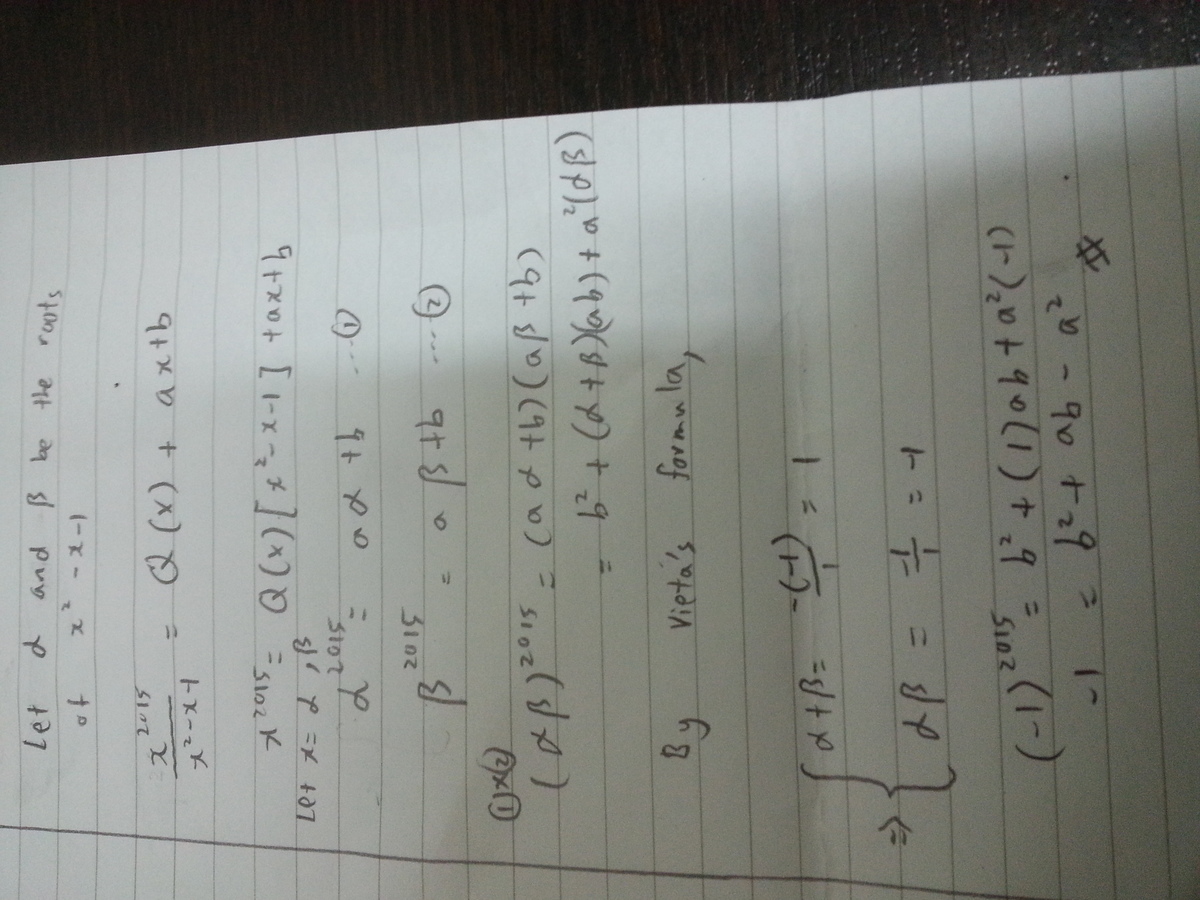More fun in 2015, Part 5
Consider the remainder a x + b when you divide x 2 0 1 5 by x 2 − x − 1 . Find b 2 + a b − a 2 .
(Part 5 of a 2015 Part series)
The answer is -1.
This section requires Javascript.
You are seeing this because something didn't load right. We suggest you, (a) try
refreshing the page, (b) enabling javascript if it is disabled on your browser and,
finally, (c)
loading the
non-javascript version of this page
. We're sorry about the hassle.
3 solutions
Our friend Brian has written a fine solution. For the sake of variety, let me show how I thought of it as I wrote the problem.
Let ϕ = 2 1 + 5 , the Golden Section, one of the roots of x 2 − x − 1 ; thus we have ϕ 2 = ϕ + 1 . We can show by induction that ϕ n = F n ϕ + F n − 1 , where F n is the nth Fibonacci number. The equation is trivial for n = 1 , and ϕ n + 1 = F n ϕ 2 + F n − 1 ϕ = F n ( ϕ + 1 ) + F n − 1 ϕ = ( F n + F n − 1 ) ϕ + F n = F n + 1 ϕ + F n .
Writing x n = q ( x ) ( x 2 − x − 1 ) + a x + b and substituting x = ϕ , we find ϕ n = F n ϕ + F n − 1 = a ϕ + b , so a = F n , b = F n − 1 , and a + b = F n + 1 .
Now b 2 + a b − a 2 = b ( a + b ) − a 2 = F n − 1 F n + 1 − F n 2 = ( − 1 ) n by Cassini's Identity. For the odd number n = 2 0 1 5 the answer is − 1 .
F n ϕ + F n − 1 = a ϕ + b does not imply that F n = a and F n − 1 = b . However, the same equation holds for ϕ , the other root of x 2 − x − 1 , so you get two equations in two unknowns and you can deduce what you want.
Or if you don't want to use ϕ , I guess you can use that a and b are clearly integers and that ϕ is irrational. Probably requires a mention though.
Log in to reply
I was thinking about this issue, but too lazy to write it down... We can note that 1 and ϕ are linearly independent over the rationals, or, as you say, keep it simple and just work with integers. Thanks for your careful reading!
This is not the ideal solution but I thought I'd get something posted anyway.
I started by dividing x 2 0 1 5 by x 2 − x − 1 using the "old-fashioned" long division method and found that the leading and trailing coefficients in the n th division step were F n + 1 and F n , respectively, (where F k is the k th Fibonacci number with F 1 = F 2 = 1 ). Since there are 2 0 1 4 division steps before getting a remainder of the form a x + b , we end up with a = F 2 0 1 5 and b = F 2 0 1 4 .
So now we have b 2 + a b − a 2 = F 2 0 1 4 2 + F 2 0 1 5 F 2 0 1 4 − F 2 0 1 5 2 =
F 2 0 1 4 ( F 2 0 1 4 + F 2 0 1 5 ) − F 2 0 1 5 2 = F 2 0 1 4 F 2 0 1 6 − F 2 0 1 5 2 = ( − 1 ) 2 0 1 5 = − 1 ,
where we have invoked Cassinin's identity .
Thank you so much for writing a solution....(+1). I was afraid I had to do it myself. Do we need to explain why those coefficients turn out to be the Fibonacci numbers, or can we let it go?
Log in to reply
I'm still thinking of the most economical way of explaining this observation. It is so immediately apparent when scribbling out the long division on paper, but to put it in Latex form would be arduous.
@Otto Bretscher Just 2010 parts to go, then?! :)
Log in to reply
I will do my best .... ;)
Log in to reply
Hahaha. I always look forward to working on the questions you post. :)
Nice solution, i had a really hard time trying to compute the answer after i found out the value of a and b
